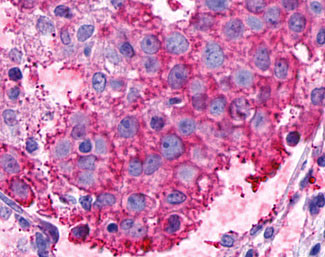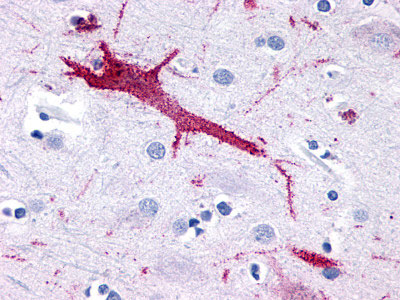ADGRF5 Antibody (N-Terminus)
Rabbit Polyclonal Antibody
- SPECIFICATION
- CITATIONS
- PROTOCOLS
- BACKGROUND

Application
| IHC-P |
|---|---|
| Primary Accession | Q8IZF2 |
| Reactivity | Human |
| Host | Rabbit |
| Clonality | Polyclonal |
| Calculated MW | 149kDa |
| Dilution | IHC-P (2-4 µg/ml) |
| Gene ID | 221395 |
|---|---|
| Other Names | Probable G-protein coupled receptor 116, GPR116, KIAA0758 |
| Target/Specificity | Human GPR116. BLAST analysis of the peptide immunogen showed no homology with other human proteins. |
| Reconstitution & Storage | Long term: -70°C; Short term: +4°C |
| Precautions | ADGRF5 Antibody (N-Terminus) is for research use only and not for use in diagnostic or therapeutic procedures. |
| Name | ADGRF5 (HGNC:19030) |
|---|---|
| Synonyms | GPR116, KIAA0758 |
| Function | Adhesion G protein-coupled receptor (PubMed:28570277). In alveolar type II (ATII or AT2) cells, required for normal lung surfactant homeostasis (PubMed:28570277). Modulation of both surfactant secretion and uptake by ATII cells is mediated by the downstream activation of GNAQ/GNA11 proteins and may be a consequence of increased cortical F-actin assembly induced by ADGRF5 activation (PubMed:28570277). In the kidney, may play a role in the regulation of acid excretion into the primary urine, possibly by regulating the surface expression of V-ATPase proton pump (By similarity). As a receptor for soluble FNDC4 (sFNDC4), required for proper systemic glucose tolerance, specifically sensitizing white adipose tissue to insulin. Also plays a role in sFNDC4-induced decrease of local inflammation in white adipose tissue (PubMed:34016966). |
| Cellular Location | Cell membrane; Multi-pass membrane protein |
| Tissue Location | Expressed in lung endothelial cells and in alveolar type II (ATII) cells (at protein level) (PubMed:23684610, PubMed:28570277). Expressed high levels in subcutaneous adipose tissue in lean individuals and at lower levels in visceral fat. Expression levels in subcutaneous adipose tissue drastically drop in obese individuals (PubMed:34016966). |
| Volume | 50 µl |

Thousands of laboratories across the world have published research that depended on the performance of antibodies from Abcepta to advance their research. Check out links to articles that cite our products in major peer-reviewed journals, organized by research category.
info@abcepta.com, and receive a free "I Love Antibodies" mug.
Provided below are standard protocols that you may find useful for product applications.
Background
May have a role in the regulation of acid-base balance.
References
Fredriksson R.,et al.FEBS Lett. 531:407-414(2002).
Bonner T.I.,et al.Submitted (DEC-2003) to the EMBL/GenBank/DDBJ databases.
Nagase T.,et al.DNA Res. 5:355-364(1998).
Ohara O.,et al.Submitted (AUG-2005) to the EMBL/GenBank/DDBJ databases.
Bechtel S.,et al.BMC Genomics 8:399-399(2007).
If you have used an Abcepta product and would like to share how it has performed, please click on the "Submit Review" button and provide the requested information. Our staff will examine and post your review and contact you if needed.
If you have any additional inquiries please email technical services at tech@abcepta.com.













 Foundational characteristics of cancer include proliferation, angiogenesis, migration, evasion of apoptosis, and cellular immortality. Find key markers for these cellular processes and antibodies to detect them.
Foundational characteristics of cancer include proliferation, angiogenesis, migration, evasion of apoptosis, and cellular immortality. Find key markers for these cellular processes and antibodies to detect them. The SUMOplot™ Analysis Program predicts and scores sumoylation sites in your protein. SUMOylation is a post-translational modification involved in various cellular processes, such as nuclear-cytosolic transport, transcriptional regulation, apoptosis, protein stability, response to stress, and progression through the cell cycle.
The SUMOplot™ Analysis Program predicts and scores sumoylation sites in your protein. SUMOylation is a post-translational modification involved in various cellular processes, such as nuclear-cytosolic transport, transcriptional regulation, apoptosis, protein stability, response to stress, and progression through the cell cycle. The Autophagy Receptor Motif Plotter predicts and scores autophagy receptor binding sites in your protein. Identifying proteins connected to this pathway is critical to understanding the role of autophagy in physiological as well as pathological processes such as development, differentiation, neurodegenerative diseases, stress, infection, and cancer.
The Autophagy Receptor Motif Plotter predicts and scores autophagy receptor binding sites in your protein. Identifying proteins connected to this pathway is critical to understanding the role of autophagy in physiological as well as pathological processes such as development, differentiation, neurodegenerative diseases, stress, infection, and cancer.



